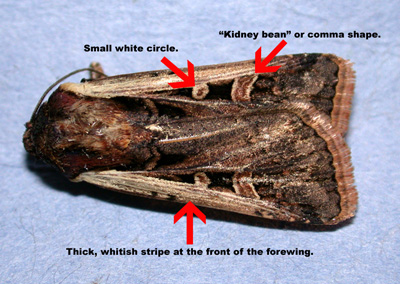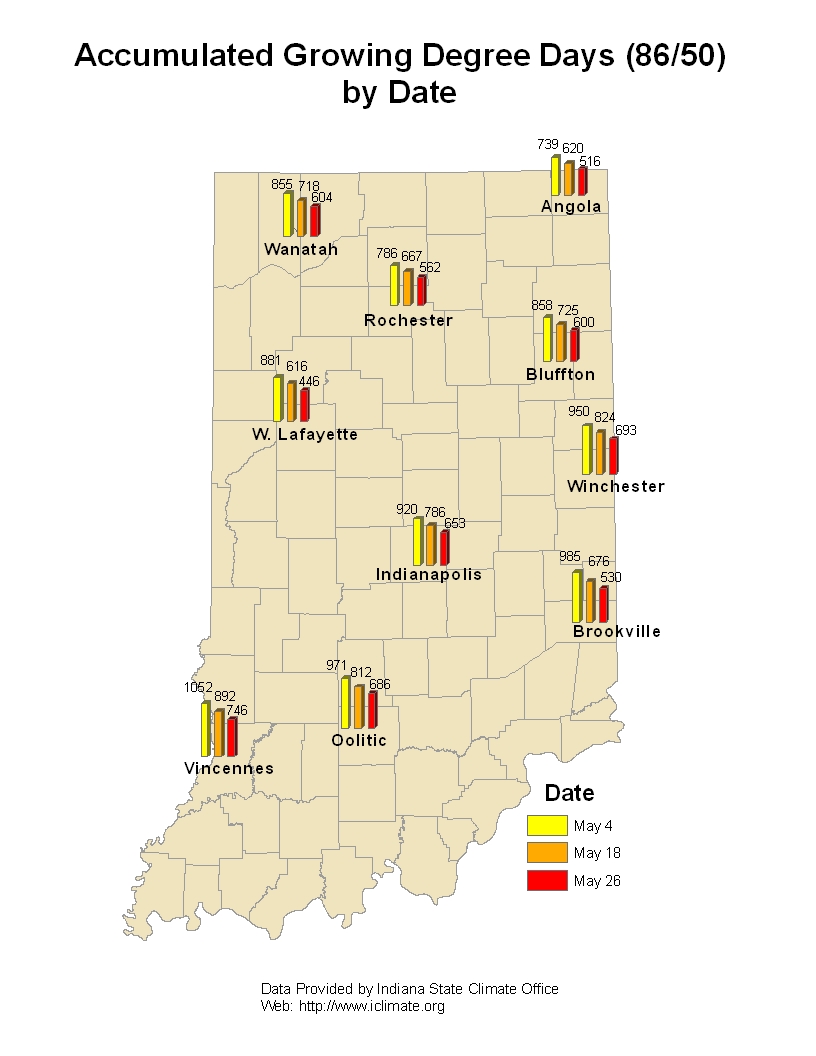Pest & Crop Newsletter, Entomology Extension, Purdue University
Western Bean Cutworm Season Begins- (Christian Krupke, John Obermeyer, and Larry Bledsoe)
- Moth captures are just beginning.
- Scouting in northwestern Indiana counties for egg masses/young larvae should begin when moth captures are frequent.
- Fields just beginning to tassel are most attractive for moth egg laying.
Pheromone trap cooperators are beginning to capture western bean cutworm moths. Over the weekend of June 27, several moths were captured, last week’s heat probably spurred their emergence from the soil. The most surprising capture was from Mike Shrack in Jay County, it is only a guess on whether that moth overwintered in that area or was transported on winds. You can track future Indiana, and other Midwestern state captures, via the Western Bean Cutworm Monitoring Network at http://www.ent.iastate.edu/trap/westernbeancutworm/ and click on “Trap Sites” under the Site Navigation on the left hand side.
Western bean cutworm eggs mass, initially eggs are white then darken (purple) just before hatching. (photo credit: University of Nebraska)
Scouting and treatment guidelines are likely only a concern for counties, where moth numbers have been highest and damage was observed last year. University of Nebraska entomologists, knowing this sporadic pest for decades, suggest that egg scouting begin once moths are being captured with regular frequency. In five different areas of a field, inspect 20 consecutive plants for egg masses which are laid on the upper surface of the top leaves of corn and/or larvae that may have hatched and crawled to the whorl and begun to feed. Moths are most attracted to cornfields that are soon, or just beginning, to pollinate. A treatment threshold of 8% of the plants with an egg mass and/or larvae in the whorl is suggested. Timeliness is critical, because as soon as pollination begins, larvae will make their way into the ear via the silks and become impervious to insecticides. This threshold has recently been tweaked by crop consultants, and suggested by Iowa State University, to be about 5% of plants infested.
Last year, damage from this pest was found only in occasional fields in northwestern counties. Hot spots within a field had numerous ears infested, but usually only one worm was found and damage was primarily in the ear tips. Last year, a field in northern Newton County near the Illinois border was noticeably damaged by this pest, click the link below to view movie of this field and severe damage. From our limited experience with this pest, areas of sandy soils and continuous corn seem to promote higher populations. Too, Cry1F (Bt protein found in Herculex 1) has shown to be very effective in suppressing this pest.
Key identification characteristics of the western bean cutworm moth.
In the weeks to follow, we will keep you abreast of observations shared from others concerning this ear-attacking insect. Too, we’ll post photos to help in worm identification. Till then…happy scouting!
Watch this movie of severe western bean cutworm damage
![]()
Click here to view the Black Light Trap Catch Report
How Long Have We Had These Problem Weeds? - (Tom Jordan)
We sometime think that just when we eliminate one weed in a field, another one comes along and takes its place. Well that is how nature works. But, have you ever wondered where “new” weeds come from once you solved a weed problem or why when you change tillage practices, you get a different population of weeds? My theory is that we have seen a few new weeds enter the state in the past 100 or so years, but if the new weed is not a grass like Johnsongrass, it probably is not a weed that will majorly impact crops. While many weeds have moved into the state with early settlers or were dropped off of wagons and railroad cars, many of the more problem species are native to the area. A few examples of weeds that were transported into the state as it was being settled are velvetleaf, prickly lettuce, kochia, and Johnsongrass.
Many of the weeds that dominated the state in the past, or the ones that we presently have in fields today, are a result of tillage practices, crop rotations, and weed management programs. In earlier days, prior to tractor-powered deep tillage, corn was usually grown about every third year with small grains and a forage legume crop produced in between. Tillage was shallow, and in the years of small grains and forages there was no postemergence tillage in those crops. Records show that the predominate weeds in Indiana from 1888 – 1929 were primarily crabgrass, a group of annual broadleaf weeds, a few biennials, and some shallow rooted simple perennials (Table 1). More people worried about wild garlic than about Canada thistle. As tractor powered equipment increased, people begin to moldboard plow and go to more monoculture crops like corn, or later a corn soybean rotation. With these practice changes, we began to see a different set of weed problems including annual broadleaf weeds and deep-rooted creeping perennials. Crabgrass was still the dominate grass (Table 2). In the 1950’s and 60’s both fertilizer and herbicide use increased. This is when we began to see giant foxtail overtake crabgrass as the predominate grass species, and also see the pigweeds, Jimsonweed, and lambsquarter species appear in crops. As herbicide selection allowed us to go to reduced or no-till, a strange thing happened (Table 3). All of those weeds that were present in fields back in the early days (Table 1) begin to reappear. However, we still managed to keep the weeds we had in the tillage years (Table 2).
By reducing tillage, those weeds that do not fare well under aggressive tillage were able to survive well under no-tillage. Since those weeds were not the major weed problems present in fields when herbicides were introduced after the early 1950’s, there was little resistance selection pressure on them. Many of the broadleaf weeds that were present during the herbicide years began to show high degrees of tolerance or resistance to herbicides. We have always had our set of major problem weeds. We have just shifted them around with tillage and herbicide use.
Table 1. Major Weed Problems 1888 – 1929 |
|
| Prickly lettuce | Broadleaf plaintain |
| Daisy fleabane | Wild carrot |
| Buffalobur | Mustard species |
| Horsenettle | Downy brome |
| Cocklebur | Crabgrass |
| Canada thistle | Wild garlic |
Table 2. Major Weed Problems 1929 – 1950 |
|
| Cocklebur | Bindweed species |
| Jimsonweed | Canada thistle |
| Velvetleaf | Morningglories |
| Quackgrass | Common Milkweed |
| Johnsongrass | Crabgrass |
Table 3. Major Weed Problems in No-till |
|
| Prickly lettuce | Morningglories |
| Canada thistle | Foxtail species |
| Daisy fleabane | Marestail |
| Horsenettle | Common Ragweed |
| Wild carrot | Giant ragweed |
| Crabgrass | Pigweed species |
| Mustard species | Common milkweed |
| Bindweed species | |





